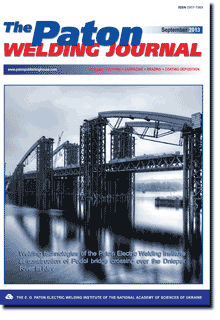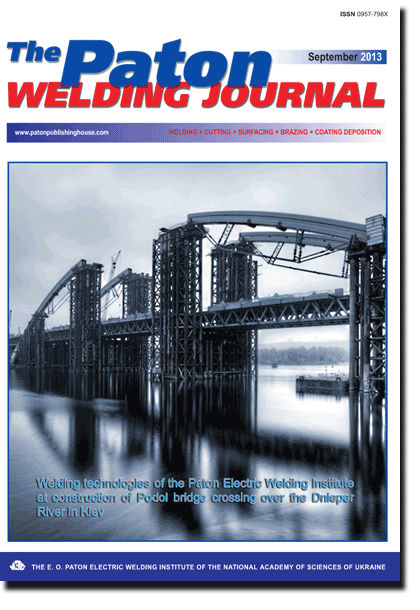| 2013 №09 (04) | 2013 №09 (06) |

The Paton Welding Journal, 2013, #9, 30-36 pages
SOME TECHNIQUES FOR REDUCING FILLER POWDER LOSSES IN MICROPLASMA CLADDING
K.A. YUSHCHENKO, A.V. YAROVITSYN, D.B. YAKOVCHUK, A.A. FOMAKIN and V.E. MAZURAK
E.O. Paton Electric Welding Institute, NASU. 11 Bozhenko Str., 03680, Kiev, Ukraine. E-mail: office@paton.kiev.uaAbstract
At reconditioning of the edges of gas turbine engine blades by microplasma powder cladding losses of cladding materials are inevitable. In order to increase the process effectiveness in this work the method of assessment of deposited bead mass at successive increase of weld pool dimensions on a wide and a narrow substrate was used to study the regularities of radial distribution of two-phase flows of microplasma-filler powder. It is established that experimental data of radial distribution of such flows on the anode surface are in satisfactory agreement with the normal distribution law. The method of calorimetry on a two-section water-cooled anode was used to evaluate the coefficient of concentration of specific heat flow of microplasma arc for cladding. It is shown that in the region of modes of microplasma cladding filler powder can be fed into the product plane with the concentration up to four times greater than the specific heat flow of the arc, and the ratio of effective diameters of powder feeding and heating spot is equal to 0.57-0.92. Influence of some design parameters of microplasmatron and process parameters of cladding on gas-powder flow concentration is described. Relationships between bead width, microplasmatron focusing nozzle diameter and characteristics of concentration of powder feeding into the weld pool required to limit filler powder losses within 1.44-2.56 % at deposition of metal of less than 3 mm thickness on blade edges are established. 11 Ref., 2 Tables, 7 Figures.
Keywords: microplasma powder cladding, blade edges, microplasmatron, coefficient of powder utilization, concentration of two-phase flow, microplasma-filler wire
Received: 26.04.13
Published: 28.09.13
References
1. Savchenko, V.S., Yushchenko, K.A., Savolej, N.I. (1993) Peculiarities of welding of high-nickel dispersion-hardened heat-resistant alloys and repair of products manufactured from them. Avtomatich. Svarka, 10, 31-33.
2. Yushchenko, K.A., Cherviakova, L.V., Nakonechny, A.A. (2002) High-strength repairs of IN738LC blades and vanes. IIW Doc. XII-1724-02-2002.
3. Yushchenko, K.A., Savchenko, V.S., Yarovitsyn, A.V. et al. (2010) Development of the technology for repair by microplasma powder cladding of flange platform faces of aircraft engine high-pressure turbine blades. The Paton Welding J., 8, 21-24.
4. Yushchenko, K.A., Yarovitsyn, A.V. (2012) Improvement of the technology for repair of upper shroud web of aircraft gas-turbine engine blades. In: Problems of resource and safe service of structures of buildings and machines. Kiev: PWI.
5. Yarovitsyn, A.V., Yushchenko, K.A., Nakonechny, A.A. et al. (2009) Peculiarities of low-amperage argon-arc and microplasma powder cladding on narrow substrate. The Paton Welding J., 6, 31-35.
6. Gladky, P.V., Pereplyotchikov, E.V., Ryabtsev, I.A. (2007) Plasma cladding. Kiev: Ekotekhnologiya.
7. Som, A.I. (1999) New plasmatrons for plasma powder cladding. Avtomatich. Svarka, 7, 44-48.
8. Rykalin, N.N. (1951) Calculations of thermal processes in welding. Moscow: Mashgiz.
9. Demyantsevich, V.P., Mikhajlov, N.P. (1973) Investigation of distribution of microplasma arc heat in displacement of center of heating spot from joint axis. Svarochn. Proizvodstvo, 6, 1-3.
10. Paton, B.E., Gvozdetsky, V.S., Dudko, D.A. et al. (1979) Microplasma cladding. Kiev: Naukova Dumka.
11. Demyantsevich, V.P., Mikhajlov, N.P. (1973) Interaction of microplasma arc with heated body. Svarochn. Proizvodstvo, 8, 2-4.
Suggested Citation
K.A. YUSHCHENKO, A.V. YAROVITSYN, D.B. YAKOVCHUK, A.A. FOMAKIN and V.E. MAZURAK (2013) SOME TECHNIQUES FOR REDUCING FILLER POWDER LOSSES IN MICROPLASMA CLADDING. The Paton Welding J., 09, 30-36.The cost of subscription/purchase order journals or individual articles
| Journal/Currency | Annual Set | 1 issue printed |
1 issue |
one article |
| TPWJ/USD | 384 $ | 32 $ | 26 $ | 13 $ |
| TPWJ/EUR | 348 € | 29 € | 24 € | 12 € |
| TPWJ/UAH | 7200 UAH | 600 UAH | 600 UAH | 280 UAH |
| AS/UAH | 1800 UAH | 300 UAH | 300 UAH | 150 UAH |
| AS/USD | 192 $ | 32 $ | 26 $ | 13 $ |
| AS/EUR | 180 € | 30 € | 25 € | 12 € |
| SEM/UAH | 1200 UAH | 300 UAH | 300 UAH | 150 UAH |
| SEM/USD | 128 $ | 32 $ | 26 $ | 13 $ |
| SEM/EUR | 120 € | 30 € | 25 € | 12 € |
| TDNK/UAH | 1200 UAH | 300 UAH | 300 UAH | 150 UAH |
| TDNK/USD | 128 $ | 32 $ | 26 $ | 13 $ |
| TDNK/EUR | 120 € | 30 € | 25 € | 15 € |
AS = «Automatic Welding» - 6 issues per year;
TPWJ = «PATON WELDING JOURNAL» - 12 issues per year;
SEM = «Electrometallurgy Today» - 4 issues per year;
TDNK = «Technical Diagnostics and Non-Destructive Testing» - 4 issues per year.


